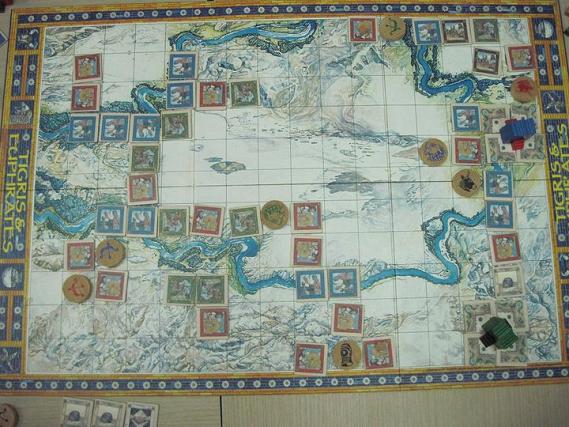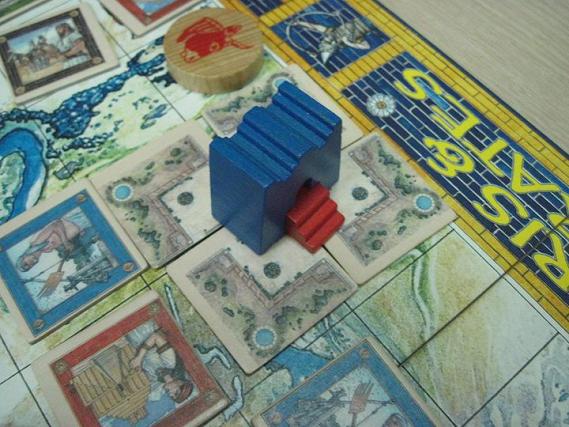16 Mar

Hmm, somehow I didn’t envision a game about the birth of civilization to be all about laying tiles on a map.
Tigris & Euphrates is one of the games that my wife and I noted early on as being almost always near the top of the best boardgames list on BGG. Although it’s a Reiner Knizia game, I labored under the impression that it was a lengthy and heavy game about the birth of civilization in the Middle East. When we finally had the chance to play it last week, I was surprised by how different it really is from the impressions I had gleaned of it. Chee Wee seemed surprised too. My thoughts:
- The rules for this game really threw me, both because it wasn’t what I expected at all and because it’s so abstract. Personally, it would have helped a bit to know that the blue leaders are farmers and the blue tiles are farms, that the red tiles are temples etc. Mind you, it wouldn’t have helped a lot. It’s still confusing to me why internal conflicts are resolved using only red temple tiles but external conflicts use the appropriate colored tiles for each attacking leader. But it would have helped some.
- Shan commented that this game is very chess-like. But perhaps Go would be a better comparison, seeing as how you need to control the game space when it comes to accessing treasures and monuments and linking kingdoms together.
- There’s still a random element here as which tiles you manage to draw has a huge impact. Shan won this game and at least part of the reason for this is that on two occasions she drew exactly the right number of the correct tiles to defend against attacks. The failed attacks dismayed the rest of us and discouraged us from attacking her again.
- But it also helped that she was the only one who built monuments and started the first one quite early. I was too caught up with opportunistically snagging points and especially treasures to even think about building monuments. Only Sean used his catastrophe tiles. I suppose they’re there to break up kingdoms that become too big to be challenged directly. I didn’t remember they existed. There are just too many small quirks in the rules.
- I think I didn’t do too badly considering how confusedly I played throughout the game. That was mostly because Chee Wee kept making obvious openings that I could exploit, notably allowing me to snag treasures a couple of times. I’m still not sure what the strategy in this game is. Are you supposed to build up your own kingdom? Or are you supposed to spot weaknesses in other kingdoms and try to meddle with them? A little of both I guess.
This is undoubtedly one of the more creative and unconventional game designs I’ve played so far. Like other Knizia games though, it’s still too abstract for me to really like it but I can’t help but admire the design.

Shan’s first monument which she managed to keep control of, at least partially, for the entire game.
Written on March 16 2011 and is filed under Boardgames.
You can follow any responses to this entry through the RSS 2.0 feed.
You can leave a response, or trackback from your own site.
Leave a Reply